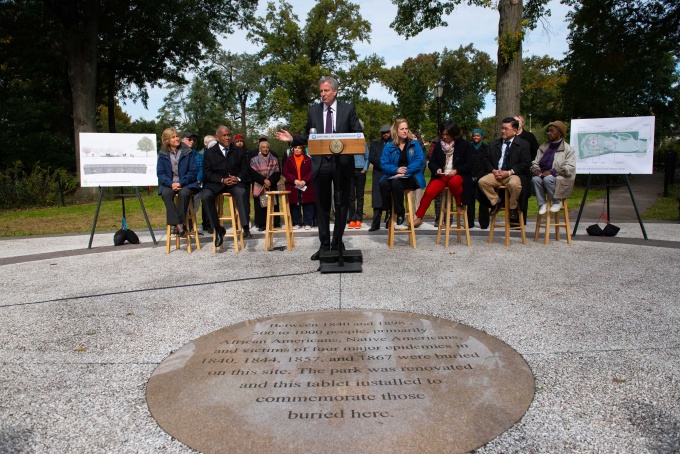
(Photo: Michael Appleton/Mayoral Photography Office)
Oct. 26, 2018 By Tara Law
Mayor Bill de Blasio and city officials unveiled designs today for a $1.6 million memorial at a long-forgotten Flushing burial ground.
The project will include the reconstruction of the existing memorial plaza and installation of a memorial at the Olde Towne of Flushing Burial Ground, located on 46th Avenue between 165th Street and 166th St.
Between 500 and 1,000 people are buried at the site, including many African Americans, Native Americans as well as Smallpox and Cholera victims.
The monument will feature a large rectangular stone box with the names of the 318 people known to be buried at the site engraved on the top, with space left for other names to be engraved. Four gravestones which were originally installed in the park will be placed inside the monument.
The mayor praised community efforts to get the site officially recognized by the City.
“Reconstructing this plaza is a way for New Yorkers to rediscover this sacred historical space, and it’s a fitting honor for those buried here,” de Blasio said.
Despite the large number of people buried at the site, the significance of the space was almost lost to history.
The site became a burial ground in the 1840s, when the Flushing community was stricken by major epidemics, according to NYC Parks.
After the epidemics, the land was a burial ground for African Americans, Native Americans and paupers until it was closed in 1898.
By the early 20th century, the land was used as an open green space for the neighborhood. Parks acquired the property in 1914, and by 1936 it was transformed into a children’s playground.
The burial ground was virtually ignored until Parks decided to launch a renovation of the site in the early 1990s.
A local activist, Mandingo Tshaka, drew attention to the site’s history, and in 1996 Parks commissioned a $50,000 archaeological study of the site. The site was discovered to be the burial ground for 500 to 1,000 people.
Between 1881 and 1898 about 62 percent of those buried at the site were African America or Native America, according to an analysis of death records. An additional 34 percent were unidentified, according to Parks.
A paved area with an engraved central stone was installed on the property in 2004, but the stone only listed the names of the four people who had gravestones at the site.
Council Peter Koo said that it is time to recognize the many people of color buried at the site.
“The community fought long and hard for a proper memorial that honors those African and Native Americans who were interned here, and their activism is finally coming to fruition,” Koo said. “With this memorial, we let the bones beneath our feet know that times have changed and the disrespect and dishonor they received in life no longer carries over into death.”
The project is being funded by $600,000 from the Borough President, $520,000 from Council Member Koo and $500,000 from the mayor.






